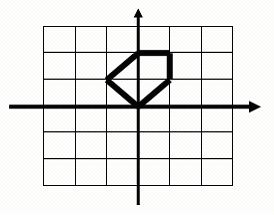Area
| Time Limit: 1000MS | Memory Limit: 10000K | |
| Total Submissions: 17456 | Accepted: 4847 |
Description
You are going to compute the area of a special kind of polygon. One vertex of the polygon is the origin of the orthogonal coordinate system. From this vertex, you may go step by step to the following vertexes of the polygon until back to the initial vertex. For each step you may go North, West, South or East with step length of 1 unit, or go Northwest, Northeast, Southwest or Southeast with step length of square root of 2.
For example, this is a legal polygon to be computed and its area is 2.5:

For example, this is a legal polygon to be computed and its area is 2.5:

Input
The
first line of input is an integer t (1 <= t <= 20), the number of
the test polygons. Each of the following lines contains a string
composed of digits 1-9 describing how the polygon is formed by walking
from the origin. Here 8, 2, 6 and 4 represent North, South, East and
West, while 9, 7, 3 and 1 denote Northeast, Northwest, Southeast and
Southwest respectively. Number 5 only appears at the end of the sequence
indicating the stop of walking. You may assume that the input polygon
is valid which means that the endpoint is always the start point and the
sides of the polygon are not cross to each other.Each line may contain
up to 1000000 digits.
Output
For each polygon, print its area on a single line.
Sample Input
4 5 825 6725 6244865
Sample Output
0 0 0.5 2
Source
【思路】
多边形求面积。
叉积计算。
【代码】
1 #include<cstdio> 2 #include<cstring> 3 using namespace std; 4 5 typedef long long LL; 6 const int dx[10]={1,1,1,0,0,0,-1,-1,-1}; 7 const int dy[10]={-1,0,1,-1,0,1,-1,0,1}; 8 9 LL ans; 10 char s[1000010]; 11 12 int main() { 13 int T; 14 scanf("%d",&T); 15 while(T--) { 16 ans=0; 17 scanf("%s",s); 18 int nx=0,ny=0,x,y; 19 int l=strlen(s); 20 for(int i=0;i<l;i++) { //为啥直接写strlen(s)会TLE =-= 21 x=nx+dx[s[i]-'1']; 22 y=ny+dy[s[i]-'1']; 23 ans += (x*ny-nx*y); 24 nx=x , ny=y; 25 } 26 if(ans<0) ans=-ans; 27 printf("%lld",ans/2); 28 if(ans&1) printf(".5"); 29 putchar(' '); 30 } 31 return 0; 32 }